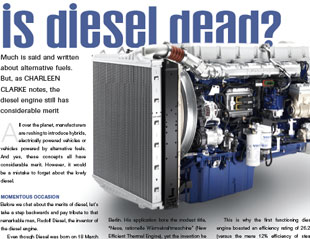Is Diesel dead?

Much is said and written about alternative fuels. But, as CHARLEEN CLARKE notes, the diesel engine still has considerable merit.
All over the planet, manufacturers are rushing to introduce hybrids, electrically powered vehicles or vehicles powered by alternative fuels. And yes, these concepts all have considerable merit. However, it would be a mistake to forget about the lowly diesel.
MOMENTOUS OCCASION
Before we chat about the merits of diesel, let’s take a step backwards and pay tribute to that remarkable man, Rudolf Diesel, the inventor of the diesel engine.
Even though Diesel was born on 18 March 1858 in Paris, rather than Augsburg, he is without doubt one of Augsburg’s most famous sons. For it was there that he attended the Königliche Kreis-Gewerbeschule, now the Holbein Secondary School, from which he graduated. And it was there that, in 1872, he made the decision to become an engineer: a decision that was to change the world. Moreover, Augsburg is where, from 1893 to 1897, on the site still occupied by MAN Diesel SE, he and engineers from MAN developed his groundbreaking invention, the eponymous diesel engine.
The early days were anything but easy, and Diesel was faced time and time again with false starts. In fact, Diesel was also almost killed by one of his engines when it exploded. A full four years passed from the first prototype to the first fully operational engine, which was produced in 1897. It had an output of a piddling 14.91 kW (20 hp), an efficiency of 26.2% and today it’s on display at the Deutsche Museum in Munich.
Diesel could scarcely have been aware of the historic importance of the patent application he submitted to Kaiserlichen Patentamt in Berlin. His application bore the modest title, “Neue, rationelle Wärmekraftmaschine” (New Efficient Thermal Engine), yet the invention he presented was anything but modest. Behind patent number 67207 lay a combustion engine that was far more efficient than any of the steam or gas-powered engines that were common at the end of the 19th century.
And today the diesel engine is still one of the most exciting and promising technologies in the hunt for new engine solutions for an increasingly eco-aware and resource-efficient world.
WHY DIESEL WORKS
But why is the diesel engine such a remarkably useful and efficient tool? The reason for the diesel engine’s success lies in Diesel’s original idea: to create an engine with the maximum thermodynamic efficiency rating – something that is achieved when as much as possible of the fuel’s energy is used to propel the vehicle, instead of literally “going up in smoke”. What is special about the diesel engine is that it compresses both air and fuel under immensely high pressure. When the fuel in the cylinder ignites owing to the heat generated by the high degree of compression, this generates the power that sets the piston in motion.
This is why the first functioning diesel engine boasted an efficiency rating of 26.2% (versus the mere 12% efficiency of steam engines around at the time).
EVOLUTION OF DIESEL
So what exactly has happened in the 112 years since the first functioning diesel engine appeared? Well, they have become far more efficient: the engines fitted to modern trucks have an efficiency rating of around 46%.
According to Maximilian Prager, a combustion engine expert at the Technical University of Munich, the diesel engine’s development can be divided into three stages. “The first step was the rapid development of the fuel injection system which took place in the early 1900s. By around 1940, the system pressure had increased from 300 bar to more than 700 bar, which meant combustion was both quicker and more efficient,” he tells FOCUS.
The second step was the development of new air compressors, a component that soon became a problem since compressors at that time were both heavy and large. With the mechanical supercharger, and later the turbine-propelled turbocharger (which Volvo Trucks introduced in trucks with the unveiling of the TD100 in 1956), air pressure could be doubled from 2 bar to more than 4 bar. This further improved the engine’s efficiency.
“The most recent major step came with the development of the electronic common rail injection system at the start of the 1990s. This maintains a constant pressure to each injector. This both raises the power output of the engine and reduces emissions,” explains Prager.
All these improvements meant that the diesel engine could strengthen its lead over other engine types. Today, a conventional petrol engine, for instance, offers a maximum efficiency rating of about 40%, which gives far lower overall efficiency in terms of fuel consumption.
“In terms of the number of litres per kilometre, the diesel engine is about 20% more efficient than a petrol engine,” explains Prager. “For one thing, you can get 10% more energy out of a litre of diesel than from a litre of petrol and, for another, the diesel engine operates about 10% more efficiently than the petrol engine.”
The diesel engine’s high-energy efficiency puts it in the lead even when it comes to emissions. However, it was long regarded as “dirty” since it produced large quantities of visible smoke made up of unburned carbon. Nonetheless, with the development of modern particle filters these emissions have been cut to a minimum. Indeed, with the latest SCR (Selective Catalytic Reduction) technology, emissions of nitrogen oxides have been considerably reduced as well.
Clear-cut examples of how the diesel engine has improved over the years can be found in many modern trucks. Take Volvo Trucks’ engines, for instance. In the space of just 20 years, they have become 100 times cleaner in terms of emissions of climate-impacting air pollutants. In parallel, power output has increased by 100% in 35 years.
As a consequence, trucks have become more and more powerful – as grateful as we are to Diesel, his little 14.91-kW (20-hp) motor is more suited to lawnmowers than trucks today. Just one example is the Volvo FH16, with its 522-kW (700-hp) engine. The world’s most powerful truck, it builds further on SCR technology but – with the help of a range of new technical solutions, including a new oil thermostat, improved exhaust brake, new piston design and a new type of engine oil – has succeeded in maintaining fuel consumption despite record-breaking power levels.
“By further developing the exhaust brake, which helps reduce the burden on the wheel brakes through electronic control, we have been able to delete a number of moving parts. This all results in better reliability, reduced weight and improved control,” explains Henrik Ask, engineer and project manager for the new D16 engine at Volvo Trucks.
LOOKING FORWARD
This is the current status quo: what of the diesel engine’s future? Will it survive the moves to “green” our planet?
I think so. Two years ago, I travelled to Stuttgart to attend the launch of Daimler’s Shaping Future Transportation initiative. The company presented 16 trucks and buses from Freightliner, Mitsubishi Fuso, Mercedes-Benz, Orion and Thomas Built Buses, which all featured alternative drive systems and fuels. Hybrid technology played a key role in those vehicles, because it reduced diesel consumption by up to 30%, depending on the application.
But the company made it very clear that diesel was far from dead. “Daimler’s diesel engines have evolved into high-tech drive systems. Emissions of particulates and nitrogen oxides have decreased by more than 90% on average since 1990. As such, they will remain the chief means of commercial vehicle propulsion for many years to come. Diesel engines still have great potential, as evidenced by their minimised emissions and continuously increasing energy efficiency,” Andreas Renschler, Daimler Board of Management member and Head of Daimler Trucks, noted at the time.
Prager concurs: “The next 10 to 15 years will be tough for engine developers as regards the increasingly stringent exhaust emission requirements. However, I believe that, for example, Volvo Trucks’ strategy – focusing on optimising both combustion in the engine and after-treatment of the exhaust gases – is the right way ahead. Focusing solely on combustion with high efficiency at low emissions will be too expensive,” he says.
At the same time, he believes that there is immense potential in the new diesel technologies that are currently being developed. “Biofuels can help further cut emissions. And hybrid diesels with single-point technology, where the diesel engine is optimised solely for long-distance operation, for instance, may promote both higher efficiency and lower production costs in the future.
“There is immense potential in the diesel engine, primarily for large engines which have to work both hard and long. The diesel engine’s high efficiency rating makes it quite simply indispensable in the development of tomorrow’s engines,” concludes Prager.
The message is clear: long live diesel!
Published by
Focus on Transport
focusmagsa



 !
From 1 Apri
!
From 1 Apri

 Big news from FOCUS on Transport + Logist
Big news from FOCUS on Transport + Logist





 FUSO: Driving the Future of Mobile Healthc
FUSO: Driving the Future of Mobile Healthc



 A brand
A brand




 Wondering about the maximum legal load for a
Wondering about the maximum legal load for a 
 The MAN hTGX powered by a hydrogen combus
The MAN hTGX powered by a hydrogen combus

 Exciting News for South African Operators
Exciting News for South African Operators
